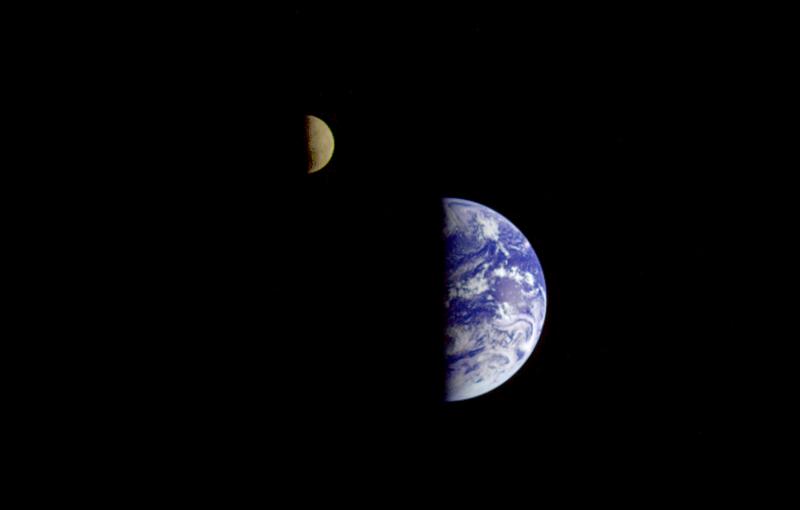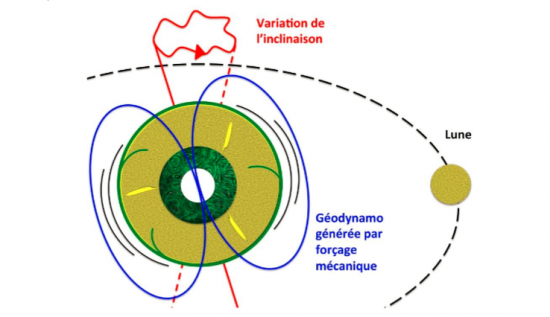The Moon would play a key role in maintaining the Earth’s magnetic field
The Earth’s magnetic field protects us every day from the charged particles and radiations coming from sunlight. This shield is produced by geodynamo: rapid movements of huge amounts of liquid iron alloy in the outer core of the planet. To maintain this magnetic field until today, the classical model claimed that the Earth’s core has cooled to about 3000 degrees over the last 4.3 billion years. A team of researchers belonging to the CNRS and the University Blaise Pascal1 suggests instead that its temperature has decreased to only 300 degrees. The action of the Moon, neglected until now, would then compensate for this difference in order to maintain active geodynamo. This work was published on March 30, 2016 within the journal Earth and Planetary Science Letters.

The classical model of the formation of the Earth’s magnetic field raised a major paradox. For geodynamo to work, the Earth would have had to be completely melted four billion years ago and its core would have had to cool slowly from about 6800°C then to 3800°C today. Recent modelling work on the early evolution of our planet’s internal temperature, and geochemical work on the composition of the oldest carbonatites and basalts are against such a cooling. If such high temperatures are ruled out, researchers propose an alternative source of energy in this study.
The Earth adopts a flattened shape, rotates around an inclined axis that oscillates around the poles and its mantle is elastically deformed by the tidal effect of the Moon. Researchers have shown that this effect could continuously stimulate the movement of the liquid iron alloy that forms the outer core, and in turn generate the Earth’s magnetic field. A power of 3,700 billion watts is constantly supplied to the Earth by transferring the gravitational and rotational energies of the Earth-Moon-Sun system, and up to more than a thousand billion watts would be available to cause such movements in the outer core. This energy is sufficient to generate the Earth’s magnetic field which, together with the Moon, solves the major paradox of the classical model. Such an effect of gravitational forces on the magnetic field of a planet is already amply documented for Io, Europa, two natural satellites of Jupiter, and many exoplanets.
Since neither the Earth’s rotation around its axis, nor the orientation of this axis, nor the moon’s orbit are perfectly regular, their cumulative influence on the movements in the core is unstable and can cause geodynamic fluctuations. This phenomenon helps to explain some of the heat pulses in the outer core and at its boundary with the Earth’s mantle. Historically, this may have led to melting peaks in the deep mantle and possible major volcanic events at the Earth’s surface. This new model emphasizes that the Moon’s influence on the Earth therefore goes far beyond the simple case of tides.

Notes :
1 Au Laboratoire magmas et volcans (CNRS/IRD/Université Blaise Pascal), faisant partie de l’Observatoire de physique du Globe de Clermont-Ferrand, à l’Institut de recherche sur les phénomènes hors-équilibre (CNRS/Aix-Marseille Université/Ecole Centrale Marseille) et à l’Institut de recherche en astrophysique et planétologie (CNRS/Université Toulouse III – Paul Sabatier).
Further Resources
- Publication scientifique : “The deep Earth may not be cooling down”, by Denis Andrault, Julien Monteux, Michael Le Bars and Henri Samuel Earth and Planetary Science Letters, 30 mars 2016. doi:10.1016/j.epsl.2016.03.020.
Contact IRAP
- Henri Samuel, henri.samuel@irap.omp.eu






